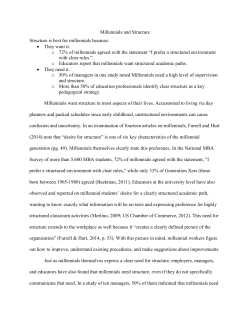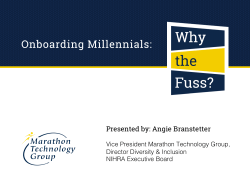
Peer-to-Peer Learning: The Best Method for Millennials Peer-to
Peer-to-Peer Learning: The Best Method for Millennials Peer-to-peer learning is best for millennials because: Collaboration: Millennials value working in groups more than previous generations. o 78% of BT’s employees say they prefer to learn from peers. o 70% of millennials get more excited when peers agree with decisions. Connection: Millennials learn best when they feel connected to the material and people. o Peer learning increase retention rates in courses, graduation rates, and GPAs. o Student satisfaction is higher when involved in peer learning. Peer-to-peer learning is basically “education of young people by young people” (Shiner, 1999, p. 555), and its roots lie in the radical work of Paolo Freire to decentralize education power structures. While used most often with K-12 students, recent research has indicated that peer education offers many benefits among college students as well (Gomez-Chavez, 2014). These benefits include increased retention rates in courses, higher graduation rates, higher GPAs, and higher student satisfaction (Crisp & Cruz, 2009). While studies of the effectiveness of peer education usually focus on traditional institutions of education, innovative businesses are also finding that peer learning is a valuable leadership training tool. AT&T uses leadership circles, self-organized, topic-based groups that provide mentoring. At the British telecommunications firm BT, they offer a peer-to-peer learning program called Dare2Share (Meister & Willyerd, 2010). Dare2Share allows employees to share their skills, expertise, and knowledge by creating short audio and video podcasts, RSS feeds, and discussion threads. BT says that the program came about as a result of finding that 78% of their employees preferred to learn from their peers (Meister & Willyerd, 2010). The success of BT’s program results from targeting the millennial population that, based on an estimate in Harvard Business Review, makes up half the employees in the world (Meister & Willyerd, 2010). In spite of the success of peer education and BT’s example, it remains an underutilized means of educating and training Millennials. M2M is the first program of its kind to model itself on cutting-edge research that indicates peer learning is the best way of training, coaching, and educating millennials, yet nonuniversity settings almost never use this method for training millennials. The effectiveness of peer-to-peer learning derives from the method’s reliance on experiential learning and collaborative interactivity. Experiential learning, according to several studies, particularly appeals to Net Generation or millennial students (Hay, 2000; Howe & Strauss, 2000). Peer education requires participants to interact with each other and work collaboratively, which millennials prefer (Tapscott, 1998). That interaction produces the kind of connectivity that millennials rely upon in learning (Pinder Grover & Groscurth, 2009). A recent study of millennials found that 70% of them are more excited about a decision when friends agree with them as opposed to 48% of non-millennials (US Chamber of Commerce, 2012). When millennials get reinforcement from peers, they learn better. M2M’s unique approach to coaching millennials through peer education taps into these research findings, but it also brings that research to the practical sphere. In small groups learners respond to each other, themselves, and the facilitator to learn and practice specific skills. As the peer facilitator models the skills or behaviors that are the focus of the module, the peer assessors learn to provide feedback and see their peers model various ways of putting that feedback into action. Research has indicated that this is an effective peer-assessment technique (Basawapatna & Repenning, 2010; Van Zundert, Sluijsmans, & van Merrienboer, 2010). In short, the research shows that peer education is the best method for teaching, coaching, and training millennials, and it also proves that a successful educational model requires innovative technologies. M2M recognizes that Millennials value education as a step toward career success (Oblinger & Oblinger, 2005). The program offers the opportunity to allay concerns of millennials that they lack the training or skills needed to advance in their careers. In fact, a recent Pew study found that 46% of millennials surveyed expressed concern about lacking training (Brack, 2012). However, current methods of providing this training do not meet the needs or wants of millenials. M2M fills that gap and offers millennials a program they cannot find anywhere else. -By Amanda D. Taylor Bibliography Basawapatna, A. R., & Repenning, A. (2010). “Cyberspace meets brick and mortar: An investigation into how students engage in peer to peer feedback using both cyberlearning and physical infrastructures.” ITiCSE '10: 184-88. Brack, J. (2012). “Maximizing millennials in the workplace.” UNC Kenan-Flagler Business School. http://www.kenan-flagler.unc.edu/executive-development/customprograms/~/media/DF1C11C056874DDA8097271A1ED48662.ashx Crisp, G., & Cruz, I. (2009). “Mentoring college students: A critical review of the literature between 1990 and 2007.” Research in Higher Education 50: 525-45. Gomez-Chavez, J. (2014). “How do peer mentors impact college students in undergraduate gateway courses at a large public university?”. Ph.D. Dissertation, University of New Mexico. Hay, L. E. (2000). “Educating the net generation.” The Social Administrator 57 (54): 6-10. Howe, N. & Strauss, W. (2000). Millennials Rising. New York: Vintage Books. Meister, J. C., & Willyerd, K. (2010). “Mentoring mill: Delivering the feedback Gen Y craves is easier than you think.” Harvard Business Review 5: 69-72. Oblinger, D. G., and Oblinger, J. L. (Eds.). (2005). Educating the Net Generation. Washington, D.C.: EDUCAUSE. http://www.educause.edu/books/educatingthenetgen/5989 Pinder Grover, T., & Groscurth, C. R. (2009). “Principles for teaching the millennial generation: Innovative practices of UM faculty.” CRLT Occasional Papers. Center for Research on Learning and Teaching, University of Michigan, No. 26. Shiner, M. (1999). “Defining peer education.” Journal of Adolescence 22: 555-66. Tapscott, D. (1998). Growing up digital: The rise of the Net Generation. New York, NY: McGraw-Hill. US Chamber of Commerce. (2012). “The millennial generation research review.” National Chamber Foundation. http://www.uschamberfoundation.org/millennial-generationresearch-review Van Zundert, M., Sluijsmans, D., & van Merrienboer, J. (2010). “Effective peer assessment processes: Research findings and future directions.” Learning and Instruction 20: 270-79.
© Copyright 2025












